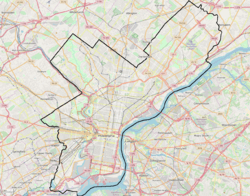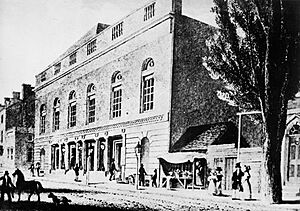Walnut Street Theatre facts for kids
|
The New Circus (1809–1811)
The Olympic (1812–1820, 1822–1828) |
|

Walnut Street Theatre in 2024
|
|
| Address | 825 Walnut Street Philadelphia, Pennsylvania United States |
|---|---|
| Public transit | 9th-10th & Locust:
PATCO Speedline
|
|
Walnut Street Theatre
|
|
| Built | 1809 |
| Architectural style | Classical revival |
| NRHP reference No. | 66000693 |
| Significant dates | |
| Added to NRHP | October 15, 1966 |
| Designated NHL | December 29, 1962 |
| Owner | Walnut Street Theatre Company (non-profit) |
| Designation | National Historic Landmark |
| Capacity | 1,054 |
| Construction | |
| Opened | 1809 |
| Rebuilt | 1828, John Haviland 1903, Willis Hale 1920, William H. Lee |
| Architect | William Strickland |
| Website | |
| walnutstreettheatre.org | |
Walnut Street Theatre is a very old and famous theater located at 825 Walnut Street in Philadelphia. It's in the Washington Square West area. This theater first opened in 1809, making it the oldest theater in the United States that is still operating today.
A group called the Walnut Street Theatre Company runs the theater. This company is a non-profit organization, which means they use their money to support the theater's mission, not to make a profit for owners. The theater has three different stages. The Mainstage is used for the company's biggest shows. The Independence Studio on 3 is on the third floor and is for smaller plays. There's also Studio 5 on the fifth floor, which other groups can rent for their own performances.
Contents
Theater Design and Features
When the theater first opened in 1809, it was called The New Circus. It didn't have a stage like theaters do today. Instead, it had a ring on the floor where performers did their acts. The building was made of brick because of fire safety rules in Philadelphia. It had a tall, pointed roof with a dome and a flagpole on top. This made it the tallest building in Philadelphia at the time.
In 1820, the dome was removed to make the sound inside the theater better. The outside of the building was changed in 1828 to look like a Greek Revival style, which was popular back then.
The Walnut Street Theatre was a leader in new technology. In 1837, it was the first theater to use gas footlights to light up the stage. Then, in 1855, it became the first theater to have air conditioning, which must have been amazing on hot days! The theater switched to electric lights, including chandeliers and footlights, in 1892. The inside of the theater was updated in 1970 to make it more modern.
In May 2019, the theater announced plans for a big expansion. This project was set to begin in 2020. However, the expansion was delayed by six weeks in March 2020 because of the COVID-19 pandemic.
History of the Walnut Street Theatre
Early Years in the 1800s
The land where the theater stands was bought in 1808 by two circus performers, Victor Pépin and Jean Baptiste Casmiere Breschard. They built The New Circus there. Pépin and Breschard had a traveling circus that performed all over the U.S. East Coast. Their shows often included circus acts, plays, and even "horse dramas" where horses performed on stage. Their first show at this location was on February 2, 1809.
In 1811, the partners hired an architect named William Strickland. He designed and built a proper stage and an orchestra pit for plays. They also bought more land to make the theater bigger. On January 1, 1812, the theater reopened with a new name: The Olympic. The first plays performed there were The Rivals and The Poor Soldier. The Olympic became well-known for its horse dramas.
Over the years, the theater changed owners several times. In 1820, it was leased by William B. Wood and William Warren. They managed another theater that had burned down. They paid for renovations and renamed the building Walnut Street Theatre. The first shows under this new name were Wild Oats and The Agreeable Surprise in November 1820. For a short time, it went back to being called The Olympic in 1822 for both horse and theater shows. By 1828, it was officially Walnut Street Theatre again.
Later, in 1863, famous actors Edwin Booth and John Sleeper Clarke bought the theater. Clarke eventually bought out Booth's share in 1871.
The 1900s and Beyond
In June 1923, the famous Marx Brothers (Harpo, Chico, Groucho, and Zeppo) performed their first show, I'll Say She Is, at the Walnut Street Theatre.
From 1932 to 1940, the theater showed movies and hosted different kinds of live shows, like vaudeville and burlesque. In 1941, it became part of The Shubert Organization, a big theater company. However, in 1956, a court ordered The Shubert Organization to sell some of its theaters, including the Walnut Street Theatre.
The Walnut Street Theatre was recognized as a National Historic Landmark on October 15, 1966. This means it's a very important historical place in the United States. In 1969, a non-profit organization bought the theater. A very important event happened there on September 23, 1976: it was the location of the first presidential debate between Gerald R. Ford and Jimmy Carter. This was a big moment in American politics.
The Philadelphia Drama Guild used the theater until 1981. Then, in 1983, the Walnut Street Theatre Company was formed by Bernard Havard. This company is a non-profit group that produces its own shows. In 1984, the Walnut Street Theatre School was started, and many students learn acting and theater skills there every year. The company puts on five main stage productions each season.
Recent Times and Challenges
In 2008, the theater celebrated its 200th season of live performances. By 2010, it had more subscribers than any other theater company in the world, with 56,000 people subscribing to their shows.
Like many places, the theater faced challenges during the COVID-19 pandemic. In March 2020, Philadelphia issued a stay-at-home order, which meant the theater had to stop live performances. They canceled the rest of their 2019-2020 season. During this time, the Walnut Street Theatre created a video series called "My Walnut Story." In these videos, former actors, designers, and staff shared how the theater had positively impacted their lives.
Famous Shows and Performers
Many famous shows and performers have graced the stage of the Walnut Street Theatre.
- Productions
- I'll Say She Is with the Marx Brothers (June 1923)
- A Streetcar Named Desire with Marlon Brando (1947)
- Mister Roberts with Henry Fonda (1948)
- Gigi with Audrey Hepburn (1951)
- The Diary of Anne Frank with Susan Strasberg (1955)
- A Raisin in the Sun with Sidney Poitier (1959)
- A Man For All Seasons starring Paul Scofield (1961)
- Performers
Many well-known actors have performed at the theater, including:
- Ethel Barrymore
- Edwin Booth
- George M. Cohan
- Claudette Colbert
- Henry Fonda
- Jane Fonda
- Marlon Brando
- Edwin Forrest
- Julie Harris
- Helen Hayes
- Katharine Hepburn
- Mark Indelicato
- Samuel L. Jackson
- Jack Lemmon
- Groucho Marx and the Marx Brothers
- Rob McClure
- Mike Nichols
- George Peppard
- Harold Perrineau
- Robert Redford
- Edward G. Robinson
- Laura San Giacamo
- Marina Sirtis
- Lucas Steele
- Jarrod Spector
- George C. Scott
- Jessica Tandy
- Ethel Waters
See also





